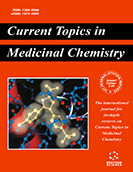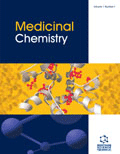摘要
背景:我们先前的研究表明,肌球蛋白磷酸酶靶向亚基1(Mypt 1)可能是促进前列腺癌(PCa)肿瘤血管生成和肿瘤生长的微RNA-30d的直接靶点,本文旨在探讨mypt 1的表达及其在前列腺癌(PCA)中的作用。 方法:在体外和体内实验中,分别观察mypt 1和CD 31蛋白在PCA肿瘤血管生成中的作用,用免疫组织化学和免疫荧光法检测mypt 1和CD 31蛋白的表达模式,并对mypt 1/CD 31结合各种临床病理特征和患者预后的相关性进行统计学分析。 结果:mypt 1抑制内皮细胞毛细血管形成,抑制体内肿瘤血管生成,抑制VEGF和CD 31的表达,mypt 1表达明显降低,CD 31表达显著增加,与前列腺良性组织相比,mypt 1表达水平显著升高,与CD 31表达水平呈显著负相关(P<0.0 5)。经统计学分析,mypt 1-低/CD 31高表达与高Gleason评分、阳性生化复发、降低PCA患者的总生存率明显相关,且高表达的PCA患者总生存期短、无生化复发、无转移,Mypt 1/CD 31组合可作为预测PCA患者无生化复发和无转移生存率的独立因素。 结论:mypt 1可抑制PCA患者血管生成,促进预后,提示mypt 1可能是一种潜在的抗肿瘤药物。
关键词: 前列腺癌,肌球蛋白磷酸酶靶向亚基1,预后,肿瘤血管生成,转移,抗癌治疗。
Current Molecular Medicine
Title:Decreased Expression of MYPT1 Contributes to Tumor Angiogenesis and Poor Patient Prognosis in Human Prostate Cancer
Volume: 18 Issue: 2
关键词: 前列腺癌,肌球蛋白磷酸酶靶向亚基1,预后,肿瘤血管生成,转移,抗癌治疗。
摘要: Background: Our previous study demonstrated that Myosin Phosphatase Targeting subunit 1 (MYPT1) may function as a direct target of microRNA-30d, which promotes tumor angiogenesis and tumor growth of prostate cancer (PCa). Here, we aimed to investigate the clinical significance of MYPT1 expression and its functions in PCa.
Methods: Roles of MYPT1 deregulation in tumor angiogenesis of PCa was determined in vitro and in vivo experiments. Expression patterns of MYPT1 and CD31 proteins were examined by immunohistochemistry and immunofluorescence, respectively. Associations of MYPT1/CD31 combination with various clinicopathological features and patients' prognosis of PCa were also statistically evaluated.
Results: Through gain- and loss-of-function experiments, MYPT1 inhibited capillary tube formation of endothelial cells and in vivo tumor angiogenesis in a mouse model with the downregulation of VEGF and CD31 expression. In addition, MYPT1 expression was significantly decreased, while CD31 expression was dramatically increased in PCa tissues compared to benign prostate tissues. Notably, MYPT1 expression levels in PCa tissues were negatively correlated with that of CD31. Statistically, MYPT1-low/CD31- high expression was distinctly associated with high Gleason score, positive biochemical recurrence, and reduced overall survival of PCa patients. Moreover, PCa patients with MYPT1-low/CD31-high expression more frequently had shorter overall, biochemical recurrence-free and metastasis-free survivals. MYPT1/CD31 combination was identified as an independent factor to predict biochemical recurrence-free and metastasis-free survivals of PCa patients.
Conclusions: Our findings indicate that MYPT1 may inhibit angiogenesis and contribute favorable prognosis in PCa patients, implying that MYPT1 might be a potential drug candidate in anticancer therapy.
Export Options
About this article
Cite this article as:
Decreased Expression of MYPT1 Contributes to Tumor Angiogenesis and Poor Patient Prognosis in Human Prostate Cancer, Current Molecular Medicine 2018; 18 (2) . https://dx.doi.org/10.2174/1566524018666180705111342
| DOI https://dx.doi.org/10.2174/1566524018666180705111342 |
Print ISSN 1566-5240 |
| Publisher Name Bentham Science Publisher |
Online ISSN 1875-5666 |
 31
31 4
4
- Author Guidelines
- Bentham Author Support Services (BASS)
- Graphical Abstracts
- Fabricating and Stating False Information
- Research Misconduct
- Post Publication Discussions and Corrections
- Publishing Ethics and Rectitude
- Increase Visibility of Your Article
- Archiving Policies
- Peer Review Workflow
- Order Your Article Before Print
- Promote Your Article
- Manuscript Transfer Facility
- Editorial Policies
- Allegations from Whistleblowers
Related Articles
-
Nuclear Hormone Receptors and Female Reproduction
Current Molecular Medicine Understanding and Applying Personalized Therapeutics at Systems Level:Role for Translational Bioinformatics
Current Pharmacogenomics and Personalized Medicine Dehydroepiandrosterone and Its Derivatives: Potentially Novel Anti-Proliferative and Chemopreventive Agents
Current Pharmaceutical Design Cancer Preventive Phytochemicals as Speed Breakers in Inflammatory Signaling Involved in Aberrant COX-2 Expression
Current Cancer Drug Targets Protein and Peptide Biopharmaceuticals: An Overview
Protein & Peptide Letters Peptide Aptamers with Biological and Therapeutic Applications
Current Medicinal Chemistry Nonsteroidal Anti-Inflammatory Drugs: Exploiting Bivalent COXIB/ TP Antagonists for the Control of Cardiovascular Risk
Current Medicinal Chemistry Inhibitors of the Ubiquitin-Proteasome System and the Cell Death Machinery: How Many Pathways are Activated?
Current Molecular Pharmacology Editorial (Hot Topic: Androgen Receptor and Prostate Cancer: New Insights in an Old Target Translate into Novel Therapeutic Strategies)
Current Drug Targets Specific Direct Small Molecule p300/β-Catenin Antagonists Maintain Stem Cell Potency
Current Molecular Pharmacology Tubulin Inhibitors: A Patent Survey
Recent Patents on Anti-Cancer Drug Discovery Detection of Predictive Markers for Therapeutic Stratification of Salivary Glands Tumors
Current Drug Targets Peroxisome Proliferator Activated Receptor α Ligands as Anticancer Drugs Targeting Mitochondrial Metabolism
Current Pharmaceutical Biotechnology Functional Peptides and Small Molecules in Medicinal Chemistry-Part I
Current Topics in Medicinal Chemistry Can an Apple a Day Keep the Doctor Away?
Current Pharmaceutical Design Antimutagenic, Antiproliferative and Antioxidant Properties of Sea Grape Leaf Extract Fractions (<i>Coccoloba uvifera</i> L.)
Anti-Cancer Agents in Medicinal Chemistry A Family of Pleiotropically Acting MicroRNAs in Cancer Progression, miR-200: Potential Cancer Therapeutic Targets
Current Pharmaceutical Design Anti-Tumor Effects of Osthole on Different Malignant Tissues: A Review of Molecular Mechanisms
Anti-Cancer Agents in Medicinal Chemistry The Leptin System: A Potential Target for Sepsis Induced Immune Suppression
Endocrine, Metabolic & Immune Disorders - Drug Targets Exosomes: A Promising Factor Involved in Cancer Hypoxic Microenvironments
Current Medicinal Chemistry

















.jpeg)








